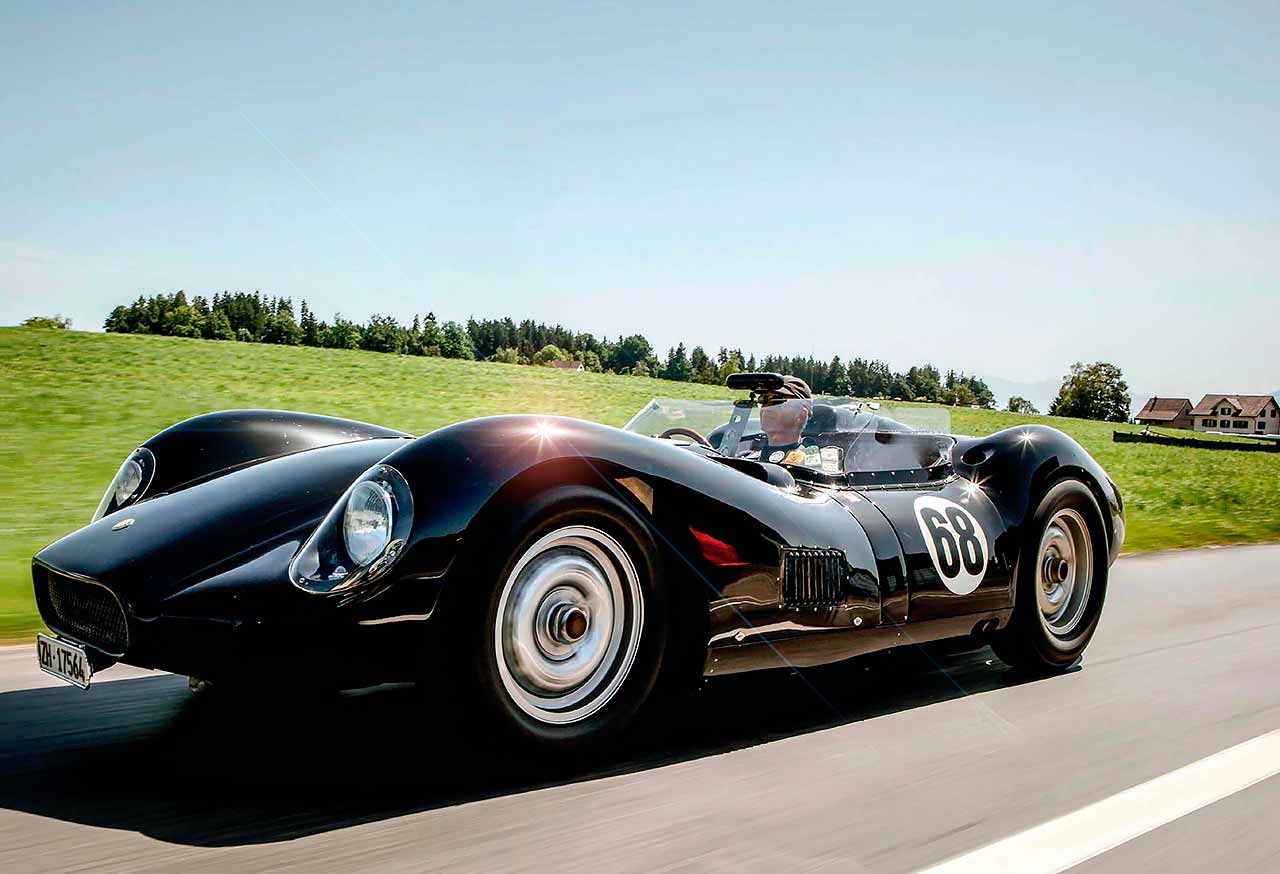
Racer Reborn. Discovered languishing in rural Oklahoma, this Lister Jaguar was restored into a spectacular road car. James Mitchell tells the story of its period competition career and fascinating later life. Photography Tony Baker/LAT/Christian Jenny.
Lister dream discovery Rebuilt racer on the road. Lister Jaguar revived Racer was rescued from a US farm.
Many of us have had tip-offs from well-meaning friends as to the whereabouts of an old car in a local junkyard or shed. They often lead only to disappointment, but not for David Reynolds of Oklahoma. A young car enthusiast and student, Reynolds had been informed by a neighbour that there was “some racing car behind a propane tank near a farmhouse in Noble”.
So he got on his bike and started cycling. Every evening, every weekend, without fail, he cycled. Then one day he saw a propane tank partly hidden behind a tree. He pedalled over and there it was: one of the most original Lister Jaguars in the world. The engine and Moss gearbox were found under a tarpaulin in an orchard 100ft away. Most of the interior body panels had been removed and stored in a galvanised bin.
The instruments, Weber carburettors and suspension all sat in a nearby shed. But most importantly, nothing was really missing. Reynolds plucked up the courage to make his move and, after brief discussions with the family, he ended up owning the component parts of chassis BHL 16. Because he was underage, he had to get a friend to sign the bill of sale…
The car’s story began in November 1958. That July, Stephen Wilder’s review of the Lister Jaguar in Sports Car Illustrated had suggested that: ‘Lacking the long-awaited E-type, Coventry’s hopes rest with the Lister Jaguar.’ So much can be taken from this phrase: Jaguar’s worrying lack of a new model, the acknowledgement that the famous D-type was past its best and, most importantly, that despite the fact that Lister was a separate firm from Jaguar, it was considered a true brethren of the marque.
The 1957 fire at the Browns Lane factory in Coventry was devastating, and dealt a killer blow to the D-type. William Lyons was acutely aware that the follow-up – ‘E2A’, the missing link between the ‘D’ and the ‘E’ – would not be ready for some years. With five Le Mans victories under its belt, there was certainly some legacy for the company to trade off, but Lyons knew that he had to keep Jaguar’s sporting prowess at the forefront of people’s minds.
With a surplus of D-type engines but no cars in which to fit them, Lyons looked for a company that could put them to good use. He found one in George Lister and Sons, an engineering firm that had, under the leadership of Brian Lister, successfully turned its hand to motor racing.
The Lister Jaguar was by no means revolutionary, but it was a well-considered and well-executed development of the D-type. Norman Dewis, Jaguar’s senior test driver and a man who probably understood the ‘D’ better than anyone else, worked closely with Lister to help him develop the car. Considering that the D-type was such an advanced automobile, there were certain components – the rear axle, for example – that seemed relatively archaic. Lister had been experimenting with a de Dion set-up and it was this adaptable, effective and above all light solution that was one of the many factors that gave the Lister Jaguar an edge over the ‘D’.
The de Dion axle sat at the back of a lightweight chassis based around two 14-gauge steel tubes. Apart from a few outriggers, there wasn’t much else to it. I’m not sure whether industrial sized vacuum-packers were available in the 1950s, but Lister seems to have got hold of one when fitting the body over the essential components. Looking at these early cars, it’s no wonder they got the ‘Knobbly’ nickname.
You only have to glance at the results of the 1957 season to appreciate the success – Archie Scott Brown won 11 of the 14 races he started, throwing in a second place for good measure. This was from a grid that often comprised Aston Martin DBR1s and Maserati Birdcages, both from big, well-funded teams.
There were only 16 production Lister Jaguars built, including the later Costin-bodied cars. BHL 16 was dispatched to the US in 1959 and supplied to Kjell Qvale Automotive Inc in San Francisco for one Mr Jack Flaherty. He was the company’s young chief mechanic, so it’s hard to say whether he really was the first owner or if he was simply representing the company. There is certainly promotional literature from a local magazine of the time that shows Flaherty taking delivery of the black, $10,500 racer. While he was a former Pacific Coast sprint car champion and clearly knew how to drive, the new Lister was the quickest thing he had yet sampled.
Flaherty enjoyed a full season’s racing in 1959, mostly in Sports Car Club of America events. The first outing was at Pomona, California, in March. He was fastest in practice but failed to finish the race. Success wasn’t far away, though, and victory came in the next two events – first at Stockton and then at Salt Lake. A second place at Laguna Seca was followed by an accident at Riverside. Perhaps it was over-confidence that led to a spin that, despite ending with the Lister mounting the guardrails, fortunately caused little damage. Flaherty was able to continue the season uninterrupted.
With the dawn of a new decade, Flaherty (or the dealership) decided that the Lister had served its purpose and it was advertised in Car & Driver after a single race in April 1960. It’s worth bearing in mind that this was a curious interim time for second-hand sports cars. The next really momentous leap forward, in the shape of the GT40, was still four years away and the bigengined Ferraris dominated endurance racing, so the Lister was still a podium contender.
‘Chuck’ Howard must have been aware of this state of limbo. He was regularly seen in the most tasty of machinery, everything from a Ferrari 250 Testa Rossa and Maserati 200S through to a Porsche 718 RSK and an Aston Martin DB3S. But it was the Lister that he raced most.
Throughout the 1960 and ’1961 seasons, Howard enjoyed BHL 16 to the full, including a victory at the Cotati road race. He was, however, a rough driver not known for his mechanical compassion. This characteristic bit him back and he destroyed the engine during one of his early outings. The block was beyond repair so a replacement was sought. A 3.8-litre road-car unit was secured and sent to Browns Lane to be converted to D-type spec. This block, stamped by the Experimental Department, was then united with the original head.
At the end of 1961, Howard decided to go and play with some of his other toys. While certain Listers were either raced to death or stripped for parts, it is this period of the tale that proves to be the most interesting. Howard sold the car in 1964 to a US Army doctor turned psychology lecturer by the name of Jack Capehart. Working at the University of Arizona, Capehart decided that he was going to repair the car himself and embarked upon a restoration.
Sadly, in 1969 he took his own life and the stripped components of the Lister were left to his family, who were devastated by their loss. The partly dismantled car disappeared to their farm in Noble, Oklahoma, a remote town of only 3000 people. This is where Reynolds enters the picture and, for many, where the tale of BHL 16 really gets interesting. Life was fairly transient, and the Lister followed him and the family around like an old pet.
By 1987, with a full-time job and money of his own, Reynolds was finally in a position to have the car restored, a task he entrusted to John Harden of Oklahoma City. Harden is a US Allard specialist and America’s foremost authority on the Lister Jaguar. He set about cleaning, straightening, welding, repairing and repainting the various parts. During this process it became apparent that not only was BHL 16 surprisingly complete and original, but that it was in relatively good condition. Unfortunately, some of the aluminium panels were too fragile to reuse, but they are still with the car today.
With the restoration finished, it was time for Reynolds to fulfil a dream first envisaged when he was a teenager. In 1992, he took the Lister to Laguna Seca and raced it for the first time since 1961, going on to display it at Pebble Beach the same year. With his ambition fulfilled, and apart from the occasional outing to Monterey, Reynolds kept the car at his Texas home.
By 2003, he had decided that it was time to let someone else enjoy it. The car was bought by Christian Jenny, who’d been struggling for many years to find a ‘D’ that matched his strict criteria of originality, history and documentation. Then, one night, he unexpectedly got a call from the American Jaguar restorer, historian and close friend Terry Larson: “How about a Lister instead?” Within 24 hours, he was the owner of a sports-racing car that helped to keep Jaguar at the forefront of everyone’s mind until the E-type could take over from where the ‘D’ had left off.
We leave the paperwork and walk down to Jenny’s garage. The Lister’s pre-warming oil system has already been on for a few hours, so, when he slides into the driver’s seat, it fires into life with only a brief push of the start button. Immediately, the first surprise – those of us who have heard Listers in the paddocks of various race circuits know just how viciously loud they can be. Not BHL 16. To road-register the Lister in Switzerland, the noise limit had to be reduced to 85dB, decreasing the sound to more of a gentle rumble than a small earthquake.
We head out into the hills above Zurich. When Reynolds had the car restored, it was built as a road car, but that doesn’t stop it feeling like a racer. Once in the driver’s seat, as in a D-type, you are totally enveloped by the bodywork. The Lister perhaps has a little more space than a ‘D’ and BHL 16 has a later, smaller steering wheel that might not look correct but which makes manoeuvring far easier.
The stubby gearstick is in line with my shoulder and the multi-plate clutch forces me to be decisive as we set off down the road. And once you’re going, boy, does it go. It flies, a road rocket of a car in the truest sense. Get into the tight hairpins of Alpine roads and the de Dion rear end comes into its own. Where a ‘D’ might start to hop and jump, the Lister remains planted and confident. To drive it in such a way is unforgettable. Whatever appearances might suggest, this is a racing car that has adapted to the road with delightful aplomb.

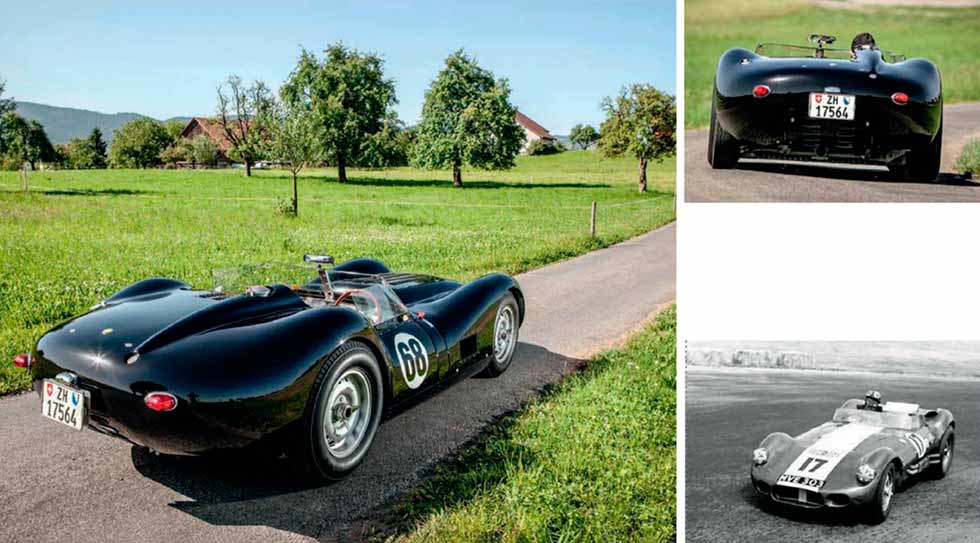
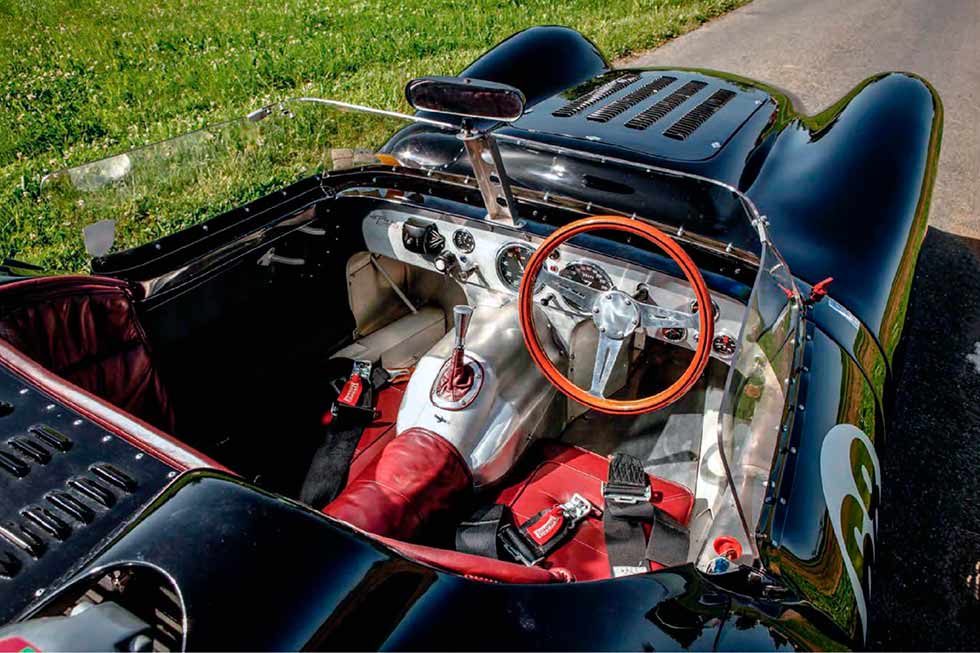
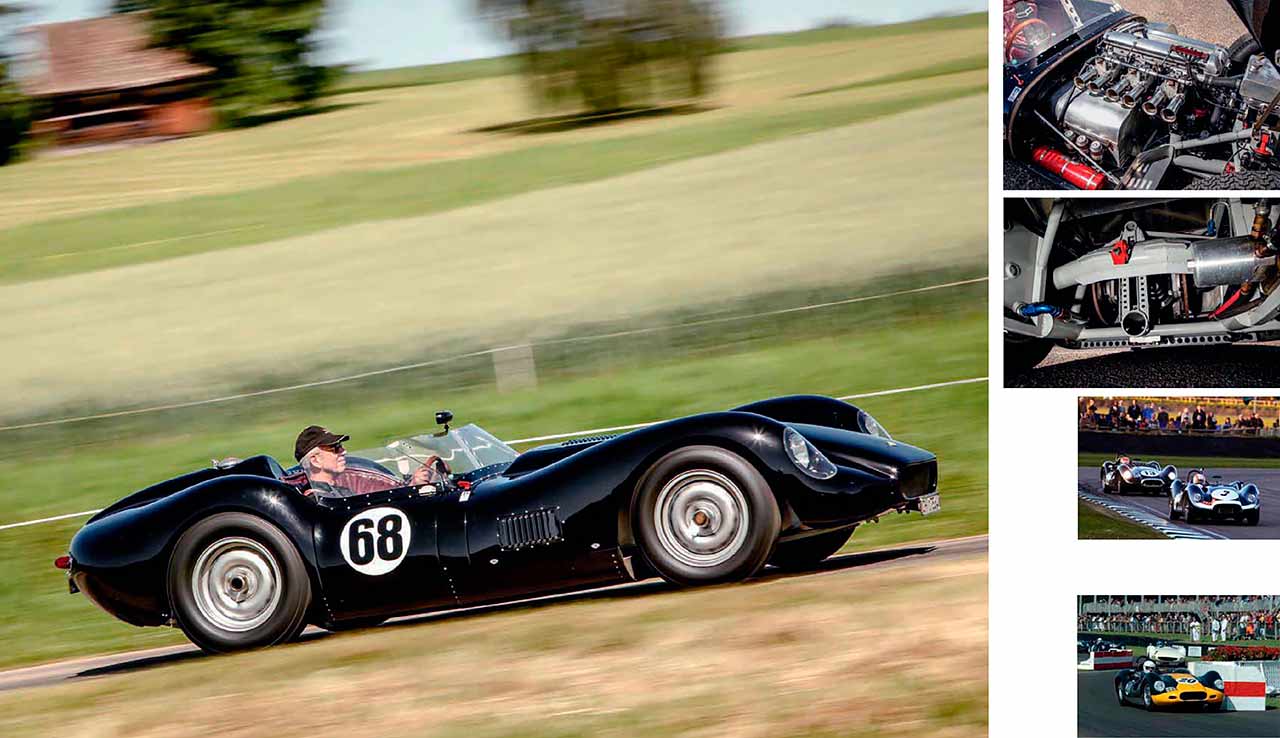
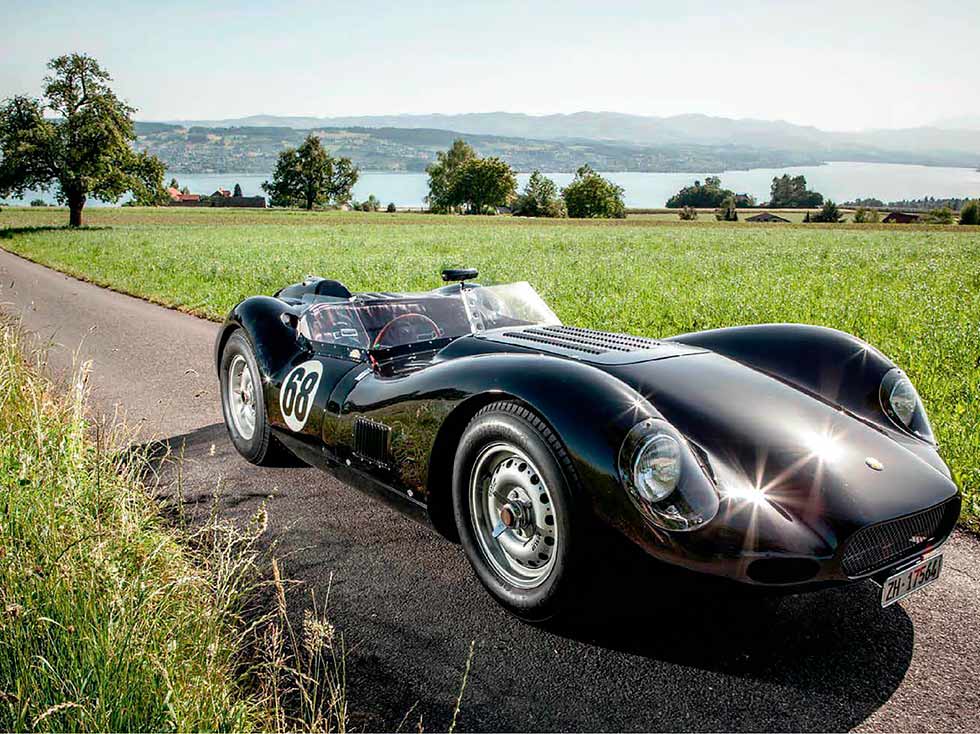
A racer’s perspective
“Mine’s actually road-registered, too!” says historics ace Shaun Lynn of his ex-John Bakaert example. “When my son Alex [now a Williams Formula One development driver] was about 12, we went for a day out in it. He was tucked down alongside me – it was fantastic.
“You get used to the fact that the driving position is very reclined and that the front corners reduce visibility. You know roughly what you’re playing with beyond the wheelarches. People have misjudged it, though…
“It’s very well balanced, and certainly nothing like my Cobra. It talks to you all the time, and won’t surprise you or bite – it gives you confidence to keep pushing because it’s telling you everything. The only challenge in period was keeping the rear brakes cool, because they’re inboard. Even now, when you’re really pressing on, it feels as if your bum’s on fire.
“The engine is fantastic, with that great roar from the exhaust and loads of power. It’s really well suited to fast, flowing circuits such as Silverstone, Goodwood and Le Mans – where you can take the Porsche Curves much quicker than you really should. It just drifts. With those skinny tyres and no camber, there’s not much mechanical grip. At somewhere a little bit tighter, though, such as the Brands Hatch Indy circuit, you’re working damned hard. The gearbox is fantastic – it’s a D-type unit, although some people fit a later E-type one – but can’t be rushed, and you have all these nimble little Cooper Monacos going underneath you the whole time.
“I’ve won at the Le Mans Classic, and going down the Mulsanne was an unforgettable experience, but the highlight so far was my battle with Sam Hancock at the 2015 Members’ Meeting [above, top, with Hancock leading] – even though I finished second. I was really at 11/10ths that day, and the car just kept talking to me. People look at it and assume that it must be a real animal because of the styling, but it isn’t. It’s got that huge heart of an engine and encourages you all the time. You really start feeling like Archie Scott Brown in there – what an amazing character he was. Archie and the Listers is the most inspiring book I’ve ever read, and what that little company achieved was fantastic.”
Big-time success
Archie Scott Brown swept all before him in 1957 aboard the works Lister Jaguar, MVE 303, setting new unlimited-capacity lap records at each circuit he visited. At Silverstone, for example, for the British Empire Trophy, he was 2 secs clear of Roy Salvadori’s smaller-engined Aston DBR1 in practice, and won comfortably.
Not until September was the Lister beaten. Salvadori arrived at the International Trophy armed with a 3.7-litre Aston as part of a four-car works assault. Scott Brown broke up the formation by hounding Salvadori all the way to the flag – after the race, it was discovered that the Lister’s springs had settled and the de Dion tube was on its bump-stops. Scott Brown’s success over the course of that famous campaign led to the customer Lister Jaguars.





